Virginia Postrel diagnoses the real reason politicians are upset about Armalite’s updated image of David’s armament:

Italian authorities were indignant when they discovered that the Illinois weapons maker ArmaLite had an advertising campaign showing Michelangelo’s David holding one of its rifles. “The advertisement image of an armed David offends and violates the law,” tweeted tourism minister Dario Franceschini. Angel Tartuferi, director of the Accademia Gallery, which houses the sculpture, agreed: “The law says that the aesthetic value of the work cannot be altered.”
This moral posturing is clearly about something other than respect for the sculpture’s “aesthetic value” or “cultural dignity.” Otherwise, officials would crack down on the David boxer shorts sold by countless Florentine vendors. And where was the outrage in 1981, when the David was flogging Rush brand poppers, amyl nitrite drugs used to enhance sexual pleasure, in magazines aimed at gay men?
It seems that it’s fine to use the David to sell things as long as you emphasize his nudity rather than his meaning.
[…]
ArmaLite’s ads broke the unwritten rules. Instead of highlighting the hero’s body, they emphatically made him a warrior. Hence Franceschini’s objection to an “armed David,” even though every David is armed. “David famously used a slingshot to defeat the giant Goliath, making the gun imagery, thought up by the Illinois-based ArmaLite, even more inappropriate,” writes Emma Hall in Ad Age.
To the contrary, the gun imagery, while incongruously machine-age, was utterly appropriate. David did not use a “slingshot.” He used a sling. As historians of ancient warfare — and readers of Malcolm Gladwell’s latest book, David and Goliath — know, a sling was no child’s toy. It was a powerful projectile weapon, a biblical equivalent of ArmaLite’s wares.








